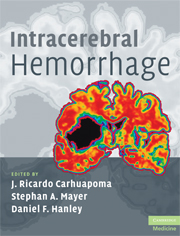
- Cited by 4
-
Cited byCrossref Citations
This Book has been cited by the following publications. This list is generated based on data provided by Crossref.
Hu, Yun-zhen Wang, Jian-wen and Luo, Ben-yan 2013. Epidemiological and clinical characteristics of 266 cases of intracerebral hemorrhage in Hangzhou, China. Journal of Zhejiang University SCIENCE B, Vol. 14, Issue. 6, p. 496.
Hetzer, Stefan Birr, Patric Fehlner, Andreas Hirsch, Sebastian Dittmann, Florian Barnhill, Eric Braun, Jürgen and Sack, Ingolf 2018. Perfusion alters stiffness of deep gray matter. Journal of Cerebral Blood Flow & Metabolism, Vol. 38, Issue. 1, p. 116.
Patriota, Gustavo Cartaxo and Reinas, Rui Paulo Vicente 2021. Neurocritical Care for Neurosurgeons. p. 501.
Musa, Mishek J. Carpenter, Austin B. Kellner, Christopher Sigounas, Dimitri Godage, Isuru Sengupta, Saikat Oluigbo, Chima Cleary, Kevin and Chen, Yue 2022. Minimally Invasive Intracerebral Hemorrhage Evacuation: A review. Annals of Biomedical Engineering, Vol. 50, Issue. 4, p. 365.
- Publisher:
- Cambridge University Press
- Online publication date:
- May 2010
- Print publication year:
- 2009
- Online ISBN:
- 9780511691836


